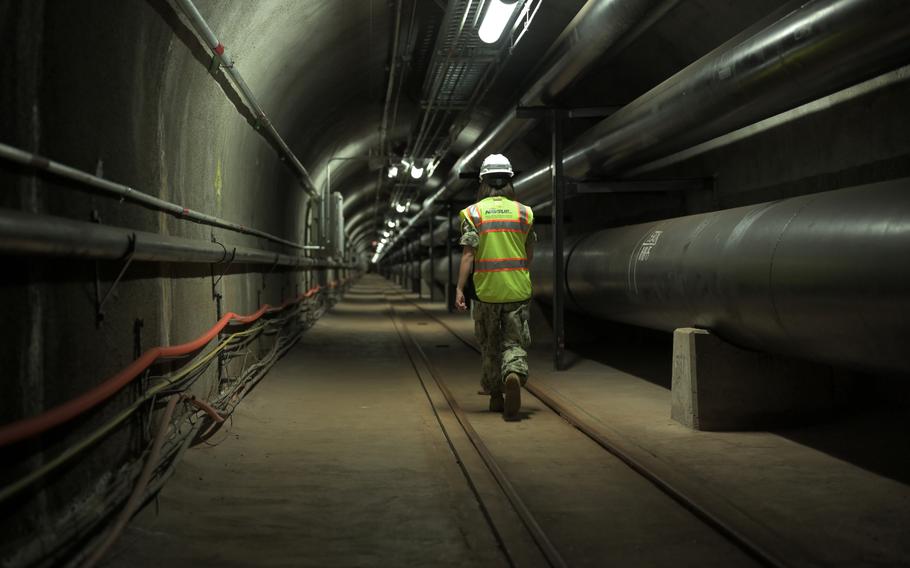
A sailor walks a portion of the 7 miles of tunnels that are part of the Red Hill Underground Fuel Storage Facility in Honolulu, Hawaii, July 17, 2020. (Daniel Mayberry/U.S. Navy)
FORT SHAFTER, Hawaii – The Hawaii Department of Health lacks the authority to issue an emergency order to close the Red Hill fuel tank facility, the Navy maintains in a document filed Wednesday.
The Navy referred to the state’s emergency order as the product of a “truncated, expedited and limited process,” and likewise dismissed a finding that the vast, underground fuel storage facility posed an “imminent peril” to the Oahu water supply.
Thousands of residents at two dozen military housing areas remain in temporary lodging after complaints surfaced over Thanksgiving weekend of foul-smelling water with an oily sheen.
The underground tanks are linked to petroleum contamination of a nearby well the Navy uses to supply water to military communities on and near Joint Base Pearl Harbor-Hickam.
The Hawaii Department of Health issued an emergency order on Dec. 6 requiring the Navy to empty the massive tanks, which now hold about 150 million gallons of fuel.
A state hearing officer on Monday recommended the emergency order be upheld after listening to 13 hours of testimony last week.
Hearing officer David Day concluded that the facility posed a “peril” to Oahu’s underground water aquifer, likening it to a “ticking timebomb.”
The deputy director of the state Health Department is required to issue a final decision on the recommendation by Jan. 28.
On Wednesday, Navy attorney Craig Jensen filed a 43-page response objecting to numerous assumptions and conjectures made in Day’s report.
Jensen argued the Health Department has exceeded its emergency authority and misinterpreted the meaning of “imminent threat” in regard to the order to empty all the tanks.
Day’s recommendation stated that the contamination was a “humanitarian and environmental disaster” and that the “threat of future releases poses an imminent peril to human health and safety or the environment at large.”
Jensen disagreed, maintaining there is no pressing danger with the facility. The Navy suspended operations there soon after residents began complaining of bad water.
“Only a finding of actual imminent peril and actions tailored to the immediate emergency are authorized under [the Health Department’s] emergency power,” Jensen wrote.
“Emergency authority and its truncated, expedited and limited process is an inadequate instrument for managing long-range uncertainty,” he wrote.
According to Jensen, the long-range risks posed by the facility are assessed and managed under a consent order entered into by the Navy, Hawaii Department of Health, Defense Logistics Agency and the Environmental Protection Agency following large fuel leak at Red Hill in 2014.
The Health Department is obligated to use a dispute resolution process set forth in the consent order if it is “dissatisfied” with the Navy’s progress in monitoring and upgrading the facility, Jensen wrote.
“The permitting process to ensure the protection of human health and the environment, and other regulatory authorities, including the [consent decree], are the proper authorities to identify, assess, and manage the risks of operating [an underground storage tank] system,” Jensen wrote.
Jensen’s rebuttal also took exception to the hearing officer’s “failure to consider critical evidence on Navy sampling, monitoring, modeling and testing actions at Red Hill” and an overstated tally of leaks that have occurred at the facility over the past 80 years.
Jensen also objected to Day’s assertion that a fuel leak associated with the underground tanks on Nov. 20 proved that the facility too old, poorly designed and difficult to inspect to prevent future releases.
The November spill, however, “did not result from a tank leak, was not caused by corrosion, age, poor design, or tank size, and was immediately discovered and reported,” Jensen wrote. “The release does not prove that Red Hill is too old, too poorly designed, too difficult to inspect, or too large to realistically prevent future releases. That release, in other words, does not support the Hearings Officer’s theory of systemic risk, and the evidentiary record does not support the conclusion that problems at Red Hill, in general, cannot be controlled.”
In a statement Thursday, the Council for Native Hawaiian Advancement said it was “disappointed but not surprised” that the Navy was contesting Day’s recommendation.
“Day found that the Navy cannot be trusted to set aside its own perceived interests to protect the health and safety of the people of Hawaiʻi and to the environment,” the statement said.